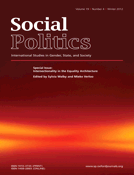-
Views
-
Cite
Cite
Mieke Verloo, Petra Meier, Sophie Lauwers, Saskia Martens, Putting Intersectionality into Practice in Different Configurations of Equality Architecture: Belgium and the Netherlands, Social Politics: International Studies in Gender, State & Society, Volume 19, Issue 4, Winter 2012, Pages 513–538, https://doi.org/10.1093/sp/jxs021
Close - Share Icon Share
Abstract
Crenshaw's powerful take against “thinking about subordination as disadvantage occurring along a single categorical axis” ( 1989, University of Chicago Legal Forum) has been taken up by many scholars and practitioners as a major challenge in legal and policy development. Yet, although her criticism is clear, the implications for practice are not. This article asks what happens when legal frameworks and institutional bodies are fragmented and at the outset not designed for intersectionality. Using the cases of the Netherlands with one equality body to deal with matters of anti-discrimination but a fragmented legal framework, and Belgium, disposing of an integrated legal framework but a separate equality body to deal with issues of gender discrimination, the article examines the potential for adopting an intersectional approach in practice. It concludes that both equality architectures have their limits, but that the Dutch one looks more promising for an intersectional approach.



